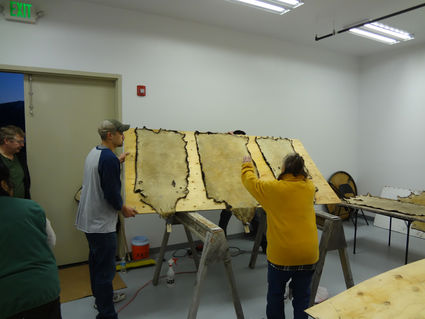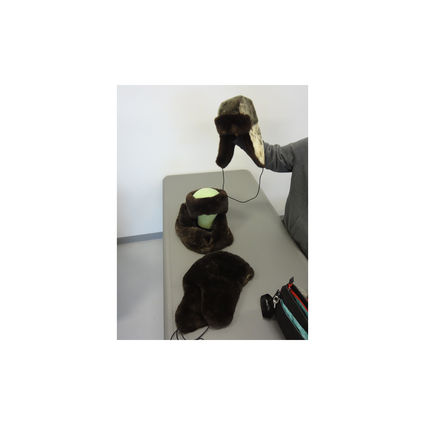Carving facility hosts first crafts class

Dan Rudy/ Wrangell Sentinel
Sea otter pelts are stretched out on a board and flipped Feb. 26 during a course put together by Sealaska Heritage Institute.
All of last weekend, the first of what is intended to be many cultural courses was held at Wrangell Cooperative Association's new carving facility, which was finished last autumn.
From Thursday afternoon through Sunday, local Native residents were shown how to craft with sea otter pelts by Jeremiah James, operator of Yakutat Furs since 2010.
"This is the ninth class I've done," James explained, and the second he has delivered in Wrangell. It was his first time working in the new facility however, and he was impressed.
"What an awesome building to be in," he commented. In particular, he said the combination of overhead and natural lighting had been helpful.
The weekend course was funded through Sealaska Heritage Institute, which hired James to teach it and also recompensed him for the pelts he provided. SHI works to perpetuate and promote Tlingit, Haida and Tsimshian cultures native to Southeast Alaska.
The class attracted a better turnout than initially anticipated, with 19 would-be furriers signing up to learn how to craft with hides.
They learned how to prepare and stretch their pelts, thread their needles, follow a pattern and carefully make their cuts. By Sunday the class was putting the finishing touches on their work, or else preparing pieces to finish at home. When they were done, they had made a variety of hats, pillows, mittens, scarves, flapped headbands, a dancing bib and cape, and other regalia pieces.
"It was wonderful," said Donna Kuntz, who took the course. She thought the course was well-presented, and was impressed with the facility. "The building is wonderful, the lighting is awesome," Kuntz said. There had been ample space for so large a group, and she looks forward to making more use of the place.
"We get to have our first weaving class Tuesday," she said, beginning about 3:30 p.m. Kuntz has met with a group for the past decade, and she said they have regularly met to work on a variety of crafts projects.
"It's not a closed group," she said, being open to anybody. Folk should bring their own supplies along, though the group has a pool of odds and ends they do share out. "It's a lot of fun," said Kuntz.
The activities and classes should become a more regular fixture of the WCA carving facility, the completion of which marked the second of three phases the tribal association plans for cultural development. Training carvers to refurbish and create new totem poles, and establishing community classes for a variety of skills are both part of the third phase.
Partakers in the weekend class also learned about the regulations involved in handling otters. There are currently a number of federal laws and regulations strictly governing who can hunt them and use their pelts.
Individuals must be able to demonstrate they are at least one-quarter Alaska Native, residing on the coast. Harvesting of otters must be for subsistence purposes or for the creation of handicraft or clothing articles. This includes alteration by weaving, carving, stitching, sewing, lacing, beading, drawing and painting.
Otters can be hunted at any time of year, and Alaska Natives are not limited in the number they can harvest. Hides and skulls must be presented to the Fish and Wildlife Service for tagging within 30 days of the kill. FWS officials will then measure the skull, examine for sex and collect a premolar for aging.
Though they cannot own or handle whole hides, handicrafts made from otter pelts may be sold to non-native persons and foreign visitors. With some restrictions, these items can also be exported abroad, provided the exporter obtains a Convention on International Trade in Endangered Species permit from FWS.
James explained he had first gotten his start as a furrier attending a class just like this one. He had attended it one winter looking for something constructive to do.

Dan Rudy/ Wrangell Sentinel
Finished crafts are displayed Sunday, following several days of work. A pair of flapcaps, a head warmer and matching scarf were just a few of the items created during the four-day workshop.
"It gets people out of the monotony of winter," he explained. In addition to giving people opportunity to socialize, classes such as these give people opportunities to learn a craft or even begin a trade.
For his business, James estimates he harvests between 100 and 140 otters each year, and 60 to 70 seals.
James added he was in part encouraged by Sitka Senator Bert Stedman, who supports efforts to control the sea otter population. Though photogenic and protected by the Marine Mammals Act, the growing otter population is often in direct competition with the region's shellfish and crab fisheries. Stedman previously sponsored a bill during the 2013 session recommending the state pay Alaska's Native community a bounty of $100 for each sea otter harvested.
The broader intention is to find more practical uses for northern sea otters, in this case promoting the local culture and potentially bringing in some additional income for families.
"That's the goal," said James.






Reader Comments(0)